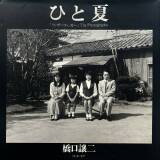We Have No Place to Be (back in stock)
.jpg)
Joji Hashiguchi
We Have No Place to Be (back in stock)
Photographs: Joji Hashiguchi
Text: Yoshitomo Nara, Mika Kobayashi
Publisher: SESSION PRESS
256 pages
Pictures: 139
Year: 2020
ISBN: 978-0-578-42908-3
Comments: Softcover, 29 x 21 cm, duotone press black and white images with vanish, design by Kumiko Otsuka. 1000 copies.
As society careened on a precipitous tilt, a generation of displaced youths fled their homes and schools, seeking refuge on the streets. Theirs was not only a flight, but a veritable fight against the stifling framework of an increasingly prescriptive life. In the early 1980s, Joji Hashiguchi similarly took to the streets of Tokyo armed with a camera, and began documenting these young compatriots in his debut work, Shisen. Before long, Hashiguchi would himself take flight – the Tokyo streets a runway for a larger world that beckoned outside Japan.
Recalling long high school nights spent listening to the Beatles, Hashiguchi first landed on the streets of Liverpool and London. Having encountered Christiane F.’s sensational 1978 autobiography, Wir Kinder vom Bahnhof Zoo (We Children From Zoo Station), he made his way from England to West Germany, traveling through Nuremberg and West Berlin. A budding Beatnik, he forayed even further West, at last arriving in New York. Over the course of his journey through these five cities, he sought to depict each through the youths that populated their streets.
Through his lens, we encounter an America exhausted by the Vietnam War. England under Thatcher, mired in rising unemployment and economic doldrums. West Berlin, on the frontline of the Cold War. Japan, erecting the scaffolding of her now labyrinthine bureaucratic society.
Nearly four decades out, Hashiguchi’s We Have No Place to Be: 1980-1982 challenges present-day viewers to reexamine what we have both become and lost.
The complexities of youth have served as a captivating theme throughout the annals of photographic history. Photographers such as Danny Lyon, Karlheinz Weinberger, Bruce Davidson, Larry Clark, Nan Goldin, and Joseph Szabo made masterpieces with their investigations into the subcultures of renegade bikers, street gangs, and rebellious adolescents teetering on the dramatic cusp of adulthood. Similarly, photographers such as William Klein and Ed van der Elsken have produced distinctive street photos, famously snapped across the world’s metropolises in the 1950s and ‘60s.
However, Hashiguchi is distinguished by a uniquely unwavering dedication to this theme. The sheer breadth of his travels in Tokyo and the West alike, coupled with a rapt intensity for documenting the “troubled youth” of the 1980s, culminated in a valuable document of an era.
Above all, Hashiguchi’s photos evince a preternatural ability to capture street youths in an unmediated, unguarded, intimate state. Eschewing a forced approach, Hashiguchi seemingly earned ready acceptance into the communities he photographed. Far from the clinical observer shining a floodlight on the city’s scars, Hashiguchi was understood by his subjects to be a sympathetic eye in their flailing struggle against authority and the contradictory injustices of society. As Hashiguchi reminisces, “I suspect their willingness to be photographed was in large part due to the simple fact that I was Asian.”
more books by Joji Hashiguchi
-
Hitonatsu (One Summer) "Father Fucker" The Photography (SIGNED)
by Joji Hashiguchi
sold -
Shisen / The Look
by Joji Hashiguchi
sold -
Oretachi, dokonimo Irarenai / We cannot stay anywhere
by Joji Hashiguchi
sold -
Kokoni itatte iijanaka / Isn't it nice to be here
by Joji Hashiguchi
Euro 75
more books tagged »subculture« | >> see all
-
Sidetripping (Signed)
by Charles Gatewood
sold -
Shinjuku gunto den 66/73
by Katsumi Watanabe
sold -
KIDS (SEALED COPY)
by Larry Clark
sold -
PORTRAITS OF AMERICAN BIKERS (SIGNED)
by Jim Miteff
sold -
LONDON BOOK
by Naoya Nakamura
sold -
Party in the back
by Tino Razo
Euro 45
more books tagged »Session press« | >> see all
-
Bible (Signed)
by Momo Okabe
sold -
New love
by Ren Hang
sold -
Solace
by Wing Shya
sold -
Taratine (Signed)
by Daisuke Yokota
sold -
FOR THE SAKE OF FUTURE DAYS
by Katsuhiro Saiki
Euro 15 -
HONEYMOON (Signed edt of 100)
by Kohey Kanno
sold
more books tagged »japanese« | >> see all
-
Kishi no Machi (A Town Already Seen)
by Kanendo Watanabe
sold -
Boso Retto' 80
by Collective
Euro 220 -
IMAGE CLUB (WITH OBI)
by Kyoichi Tsuzuki
Euro 55 -
Almost Paradise (Signed)
by Kosuke Okahara
sold -
ARCHITECTURAL APOCALYPSE (WITH ACETATE AND OBI)
by Ryuji Miyamoto
sold -
A Sentimental Journey (Original edition)
by Nobuyoshi Araki
Euro 3800
more books tagged »eighties« | >> see all
-
The Stage
by Donigan Cumming
sold -
I Wanna be me
by Collective
sold -
Das Auge, die Gedanken, unentwegt wandernd
by Walter Pfeiffer
sold -
Masquerade Party
by Masaru Mera
sold -
New York Reports
by Ryoji Akiyama
sold -
NIHON MURA 1969-79 (SIGNED WITH OBI)
by Shuji Yamada
sold
Books from the Virtual Bookshelf josefchladek.com





























;jpg)





 Facebook
Facebook Instagram
Instagram